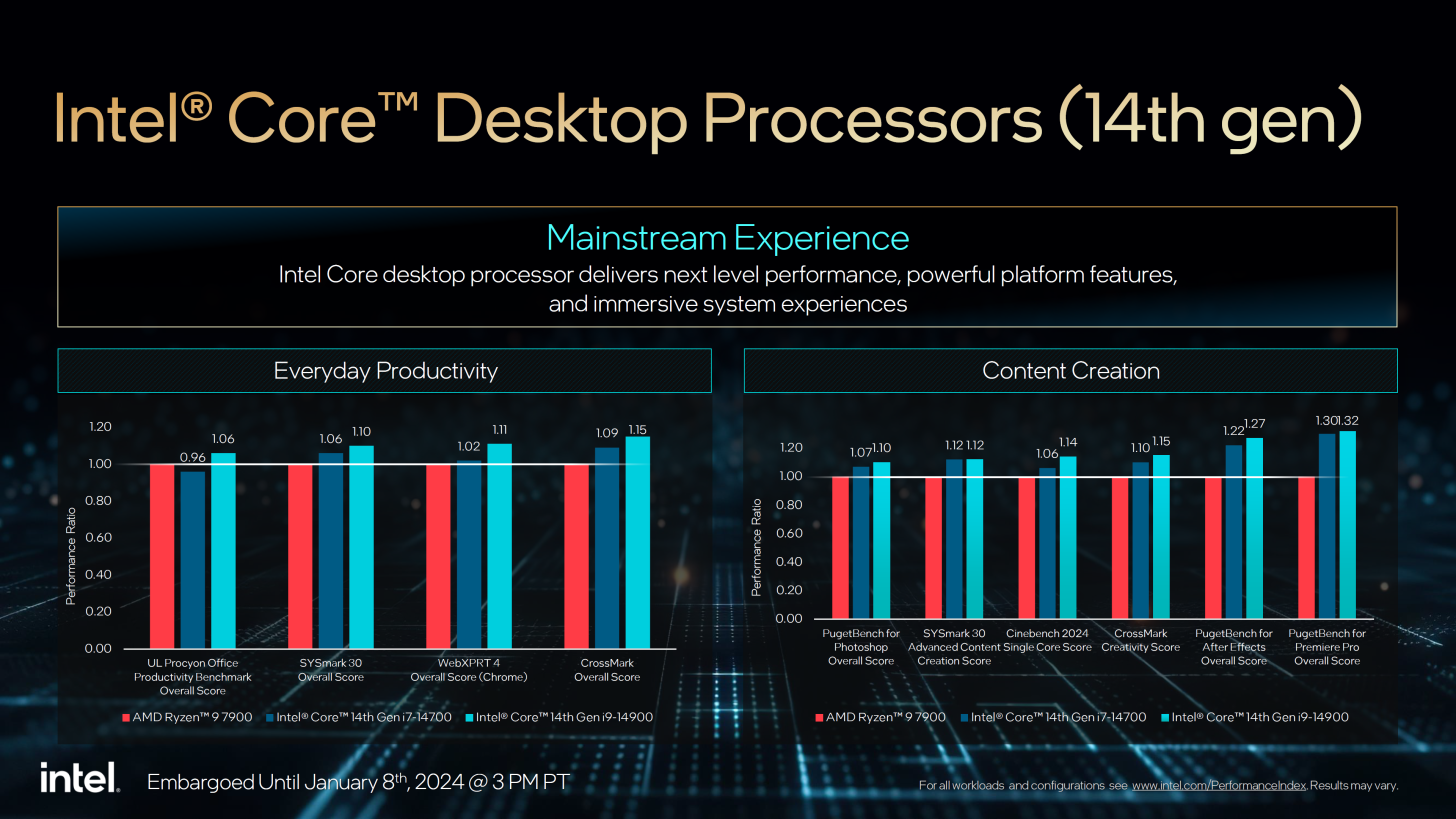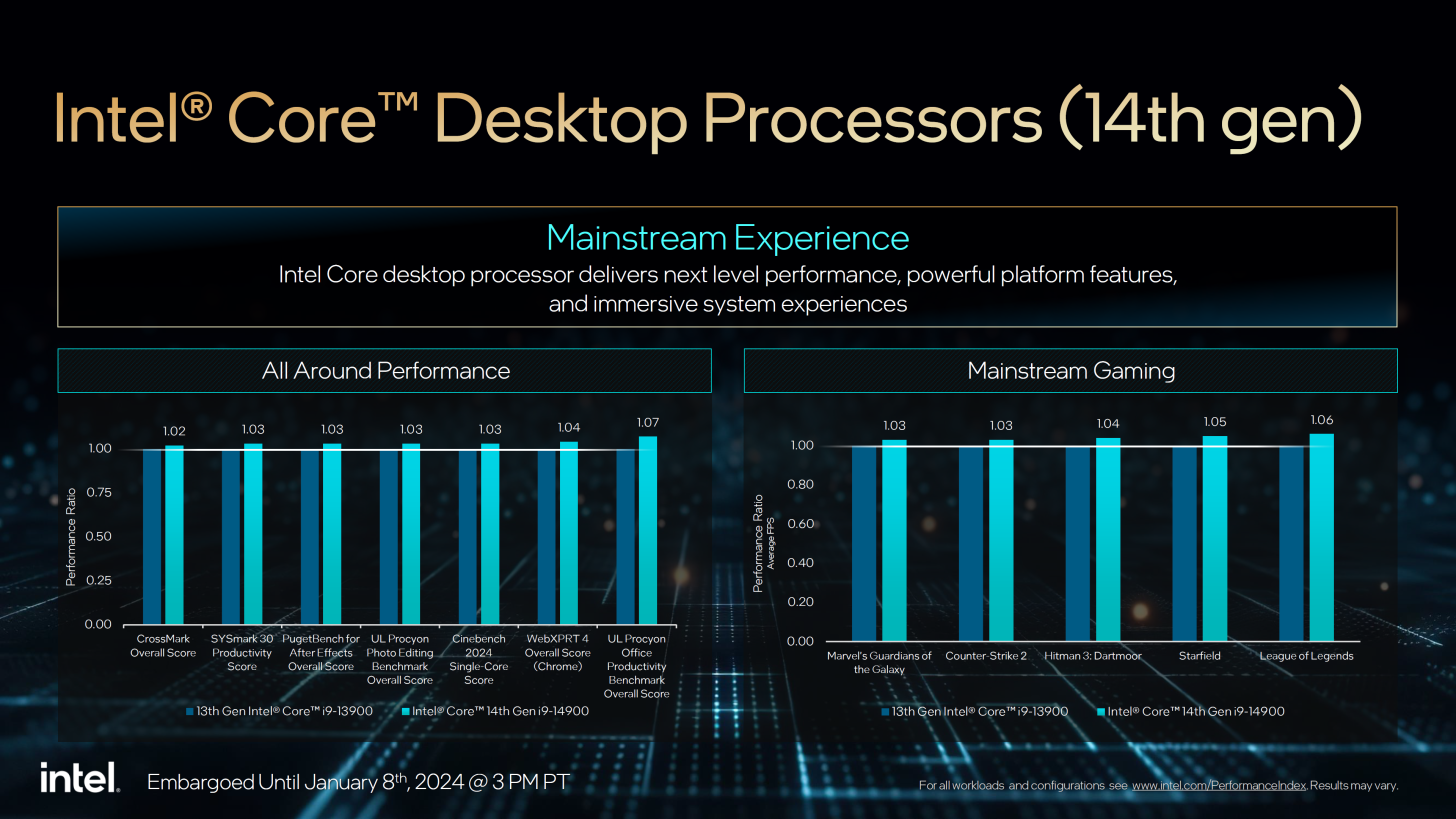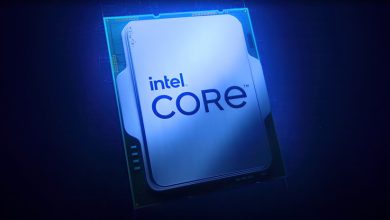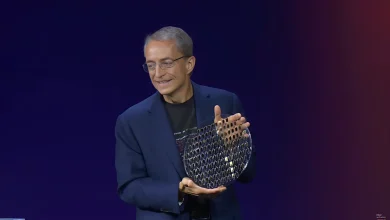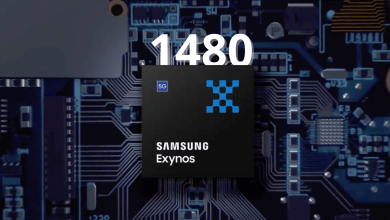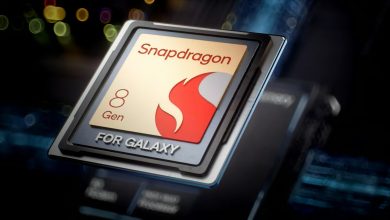Intel Launches the 14th Generation Non-K, Mobile HX & Core 100U Lineup at the CES 2024
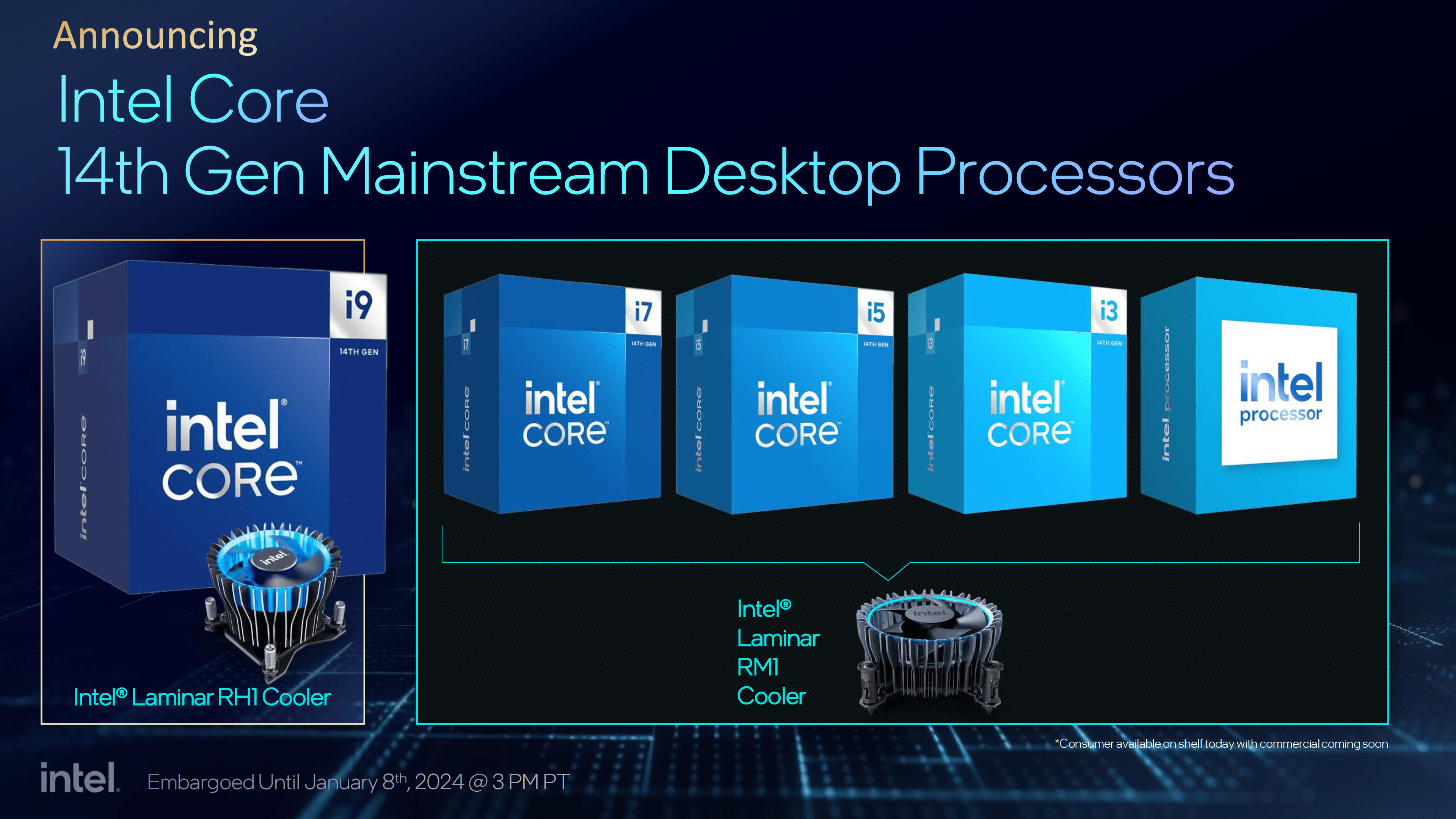
Wrapping up CES for the 3 top dogs, Intel has taken the stage to unveil its long-awaited 14th Generation Non-K and mobile-HX series of CPUs. This move bids farewell to the ‘Core i‘ naming convention, as Intel moves on to a new era of ‘Core Ultra‘.
These processors feature no support for overclocking, having a TDP of just 65W, or 35W for the T-variants. The HX series on the contrary is designed for high-end, flagship-level laptops, delivering workstation-caliber performance.
Architectural Changes
For more context, in October last year, Intel formally lifted the curtains on Raptor Lake Refresh. These CPUs are merely a refresh of Raptor Lake (13th Generation), which itself can be considered a refresh of Alder Lake (12th Generation).
While Raptor Lake itself boosted clock speeds and cache counts by a significant amount, Raptor Lake Refresh is but a stopgap measure to counter Zen4-X3D. What we’re trying to say is that the 14th Generation has no actual architectural improvements over the 13th Generation.
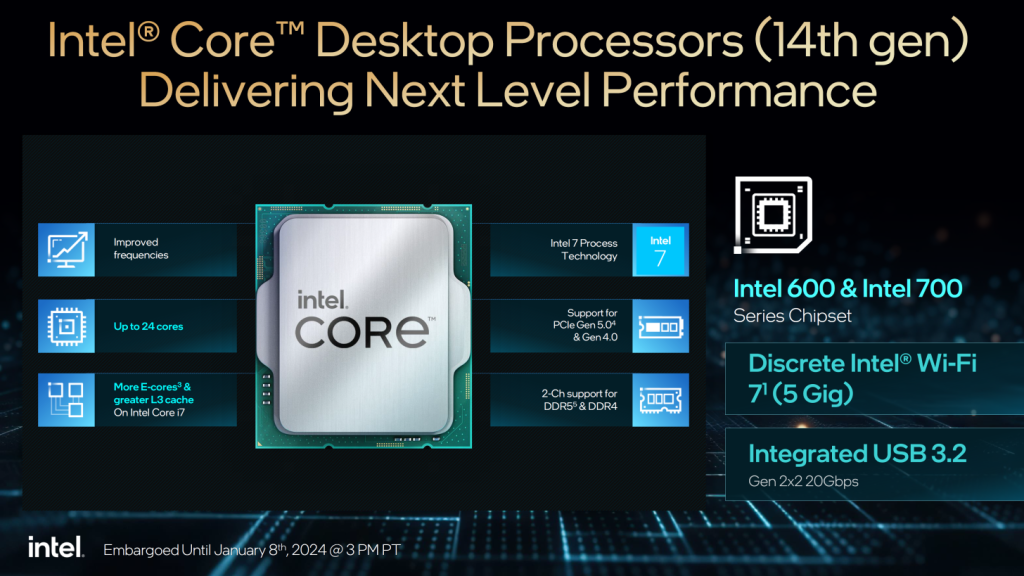
All formalities aside, a very important point is that all CPUs lower in specifications than the i5-14600 can only use DDR5-4800 memory. This is so because they are based on the C0 silicon revision, which signifies an Alder Lake die. A primary affectee is the i5-14400, present in both B0 and C0 silicon flavors. DDR4 support remains unchanged, however.
- Raptor Cove P-Cores
- Golden Cove E-Cores
- Up to 24 Cores / 32 Threads
- 2MB of L2 Cache per P-Core
- 4MB of L2 Cache per E-Core Cluster
- 3MB of L3 Cache per Slice
- Support for DDR4-3200 / DDR5-5600 Memory (B0) or DDR5-4800 Memory (C0)
- Intel 7 Process Technology
- Support for Existing LGA 1700 (600, 700-series boards) platform
It is effectively the same silicon, binned a little finer, which leads to somewhat faster clock speeds. Still, today’s discussion is regarding the Non-K and HX lineup, spreading over the i3, i5, i7, and i9 families.
Meet the Budget 14th Generation (65W) Lineup of CPUs
-i9 Family
Starting off with the top dogs, we have the Intel Core i9-14900 alongside its low-power (T) and iGPU-less variants (F). The i9-14900 features 24 cores (8P+16E) and 32 threads, with a base and boost clock of 2GHz and 5.8GHz respectively.
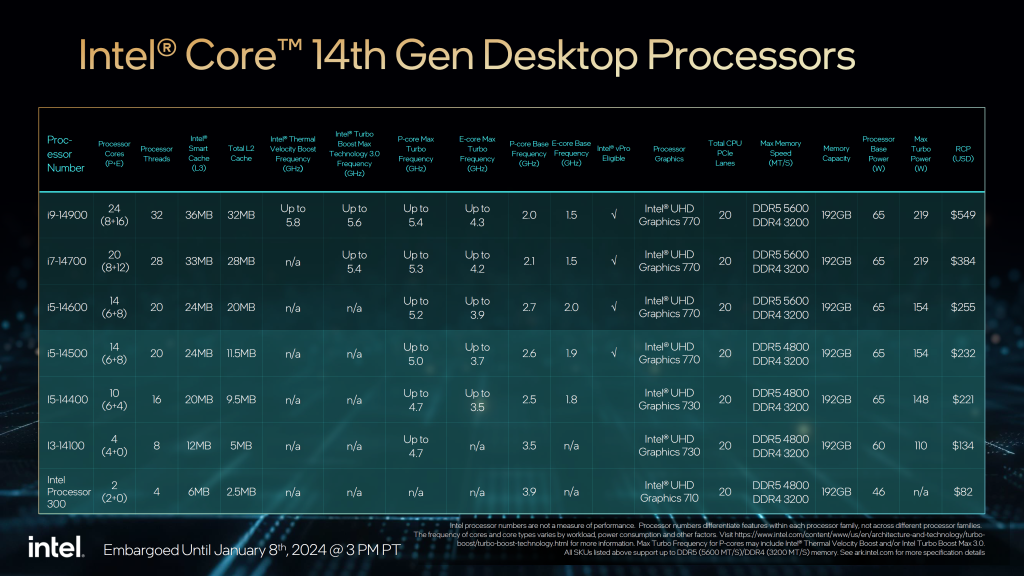
In the cache department, we see 32MB of L2 Cache and 36MB of L3 Cache, quite impressive until you realize that it is the same as the i9-13900. Reiterating, the only improvement Intel is offering is in the clock speeds. The i9-14900 will cost $549.
-i7 Family
Lower down the stack, the i7 14th Generation non-K family presents the i7-14700 in parallel with its T and F variations. The i7-14700 much like its unlocked brother offers 20 cores (8P+12E) and 28 threads. The CPU operates at a base clock of 2.1GHz, going as high as 5.4GHz.
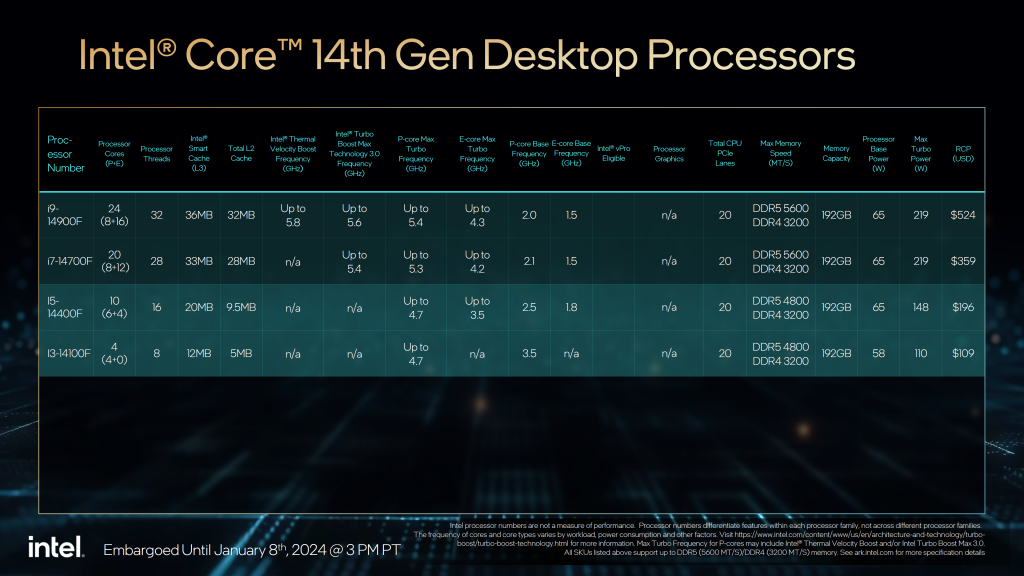
If we do the calculations, the i7-14700 hosts 28MB of L2 Cache and 33MB of L3 Cache. Interestingly, this is higher than the i7-13700, primarily because i7s from the 14th Generation feature 4 extra E-Cores, leading to higher cache counts. Coming in at $384, we’ll have to see how it performs against its AMD analog.
-i5 Family
The i5 segment has a total of 3 different contenders including the i5-14400, the i5-14500 and the i5-14600. The i5-14400 features 10 cores (6P+4E) and 16 threads, with base and boost frequencies of 2.5GHz and 4.7GHz. Adding to the mix, it depends on luck you’ll get the B0 or C0 version, as was the case with last year’s i5-13400.
The i5-14500 likewise is packed with 14 cores (6P+8E) and 20 threads. A key identifier between the 14500 and the 14600 is the slower clock speeds and the silicon used. Clocking in at 2.6GHz (Base) and 5GHz (Boost), the 14500 is based on an Alder Lake C0 die, limiting its memory speed to DDR5-4800.

Last but not least, the i5-14600 as stated above has 14 cores (6P+8E) and 20 threads, running at 2.7GHz (Base) and 5.2GHz (Boost). This is the only i5 product to be built using the B0 silicon, which greatly enhances memory support.
As for the price tag, the i5-14400, i5-14500, and i5-14600 will hit shelves priced at $221, $232, and $255 respectively.
-i3 Family
Intel’s i3 lineup has been the cream of the crop on the budget side of things, and a haven for inexpensive yet performant PC builds. How well these CPUs will hold up this year, we’ll have to see. Anyhow, the i3-14100 is not an upgrade over its predecessor, being a quad-core processor with base and boost clocks of 3.5GHz and 4.7GHz respectively.
The CPU features 8MB of L2 Cache and 12MB of L3 Cache, in tandem with support for DDR4/DDR5-4800 memory. There’s a famous saying, “There are no bad products, only bad prices“, which can very well apply to the i3-14100 since it comes in at just $134. Of course, we’ll leave the rest to independent reviewers.
Oh, we almost forget the Intel Processor 300, the successor to the Pentium Gold lineup. The Intel 300 has 2 P-Cores and 4 threads, at 3.9GHz. The CPU consumes 46W of power and has an MSRP of $82.
Core 100U Series
The Core 100U series is a small update to the Core Lineup without the Ultra distinction. Intel has launched 3 new CPUs using Raptor Lake silicon, so no, these CPUs aren’t based on Meteor Lake. The 3 options range between 6 cores and 10 cores, with a base TDP of 15W and a max turbo power of 55W.

These CPUs can run DDR5-5200/LPDDR5x-6400 memory, and DDR4-3200/LPDDR4x-4267 memory with ease. The Core 7 Processor 150U, which is this lineup’s flagship, is rated for a maximum clock speed of 5.4GHz.
Mobile Flagship HX Series: Up to 24 Cores & Boost Clocks of 5.8GHz
Based on desktop silicon, Intel’s HX series is reserved for enthusiasts, with up to 24 cores and 32 threads. These processors have a base TDP of 55W, going as high as 157W. Additionally, there is support for WiFI 7, Bluetooth 5.4 and Thunderbolt 5, delivering 2x speed over its predecessor.
All HX series processors may use a max of 192GB of DDR4-3200/DDR5-56000 memory and can manage near desktop-level clock speeds.
Among the CPUs, we have the b with 24 cores (8P+16E) / 32 threads, going up to a whopping 5.8GHz. Next up is the i7-14700HX with 20 cores (8P+12E) / 28 threads, providing a Turbo frequency of 5.5GHz.
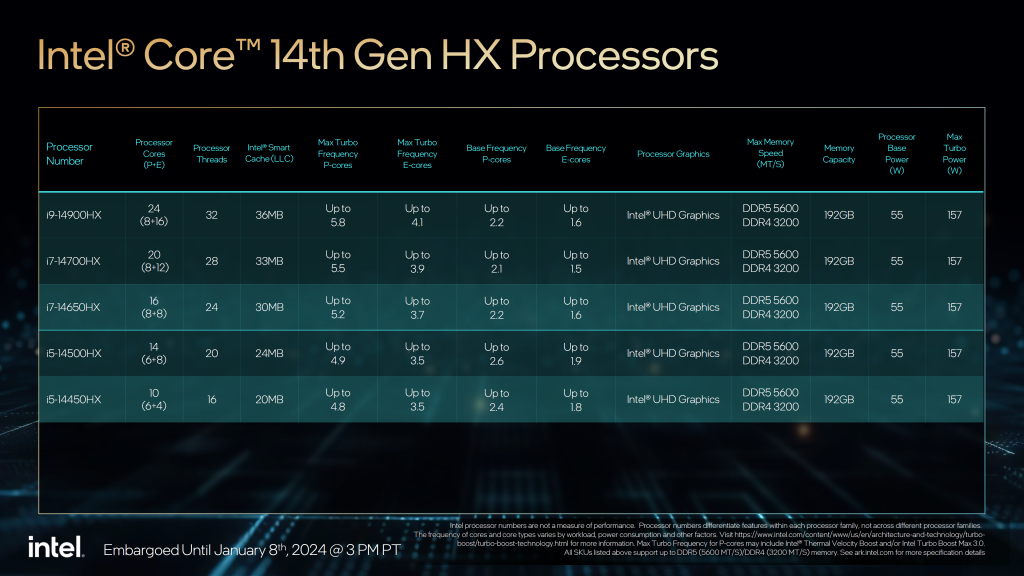
The i7-14650HX and i5-14500HX follow with 16 (8P+8E) and 14 (6P+8E) cores, at 5.2GHz and 4.9GHz. Lastly, there is the i5-14450HX equipped with 10 cores (6P+4E) and 16 threads, boasting a max single thread frequency of 4.8GHz.
Performance
-14th Generation non-K:
Starging off with the non-K series, the i9-14900 when normalized against AMD’s Ryzen 9 7900 trades blows in various benchmarks. Throughout everyday productivity tests, Intel is seen with a lead of 15%, which rises to 32% in content creation.
Against last-generation’s i9-13900, Intel promises an up to 7% uplift in all around performance. If we move over to gaming, the delta decreases to 6%, thanks to the faster clock speeds.
-14th Generation HX:
The mobile HX series i9-14900HX beats AMD’s Ryzen 9 7945HX in UE 5 based tests by a margin of 51%. Other tests such as CrossMark, DaVinci Resolve, Cinebench 2024 Single Core, and SYSmark 30 also see the Intel chip in lead.
On the gaming side of things, Intel has a slow start against the Ryzen 9 7945HX/HX3D, though it quickly picks up pace, leaving an up to 17% performance increase. Of course, results will vary significantly from game to game.
Without the X3D chip in way, the i9-14900HX simply outmatches the Ryzen 9 7945HX in almost every showcased AAA and eSports title. Intel is also bringing APO to the Core i9 and Core i7 HX series, netting an 18% performance gain in various titles with support for more en route.
